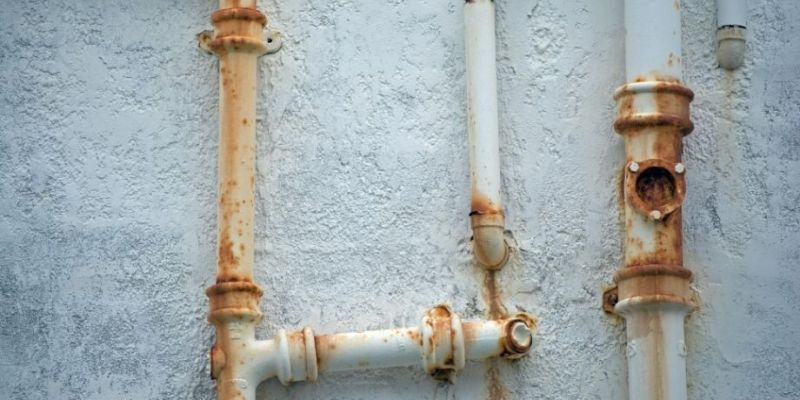Numerous individuals find the unique charm and character of older homes appealing. However, that charm frequently comes with a number of plumbing issues. Older homes’ plumbing systems may deteriorate over time, causing problems that need to be fixed. In this article, we’ll look at “What Are the Common Plumbing Problems in Older Homes?” and offer practical solutions.
What Are the Common Plumbing Problems in Older Homes?
Outdated Pipes
One of the Biggest Issues in Older Homes Are Pipes That Are Out Of Date. There may still be galvanized steel, cast iron, or even lead pipes in these homes. Reduced water flow, leaks, and water discoloration are all possible outcomes of corrosion-prone materials like these.
One of the primary concerns in older homes is outdated plumbing pipes. These homes may still have pipes made of galvanized steel, cast iron, or even lead. These materials are more prone to corrosion and can result in reduced water flow, leaks, and water discoloration. Upgrading to modern plumbing materials like copper or PEX can help prevent these issues.
Leaky Faucets
Leaky faucets are a common annoyance in older homes. Over time, the washers, seals, or cartridges in faucets can wear out, leading to leaks. These leaks not only waste water but also contribute to higher water bills. Repairing or replacing the faulty components can fix this problem and save both water and money.
Clogged Drains
Clogged drains can be a frequent occurrence in older homes due to a buildup of debris, sediment, or tree roots infiltrating the sewer lines. This can cause slow drainage or even complete blockages. Regular drain cleaning and the use of drain screens can help prevent clogs and keep the plumbing system running smoothly.
Low Water Pressure
Older homes may suffer from low water pressure, which can be frustrating when trying to use multiple fixtures simultaneously. This issue can be caused by various factors, including corroded pipes, mineral deposits, or inadequate water supply. Installing pressure-boosting devices or upgrading the plumbing system can help improve water pressure.
Running Toilets
A running toilet is not only a waste of water but also a nuisance. Faulty flappers, damaged fill valves, or improperly adjusted floats can cause toilets to continuously run. Replacing these components or adjusting the mechanisms can resolve the issue and prevent unnecessary water usage.
Sewer Line Issues
In older homes, sewer line problems can arise due to tree root intrusion, ground shifting, or deteriorated pipes. These issues can lead to sewage backups, foul odors, or slow drains. Professional inspection, repair, or replacement of the sewer lines may be necessary to ensure proper functioning of the plumbing system.
Water Heater Problems
Older homes may have outdated water heaters that are less energy-efficient and prone to issues. Common problems include sediment buildup, leaks, or a lack of hot water. Flushing the water heater regularly, replacing faulty components, or upgrading to a new, efficient model can help overcome these problems.
Corroded Plumbing
Corrosion is a significant concern in older homes with outdated plumbing systems. Corroded pipes can lead to leaks, reduced water quality, and even pipe bursts. Identifying and replacing corroded sections of plumbing pipes is crucial to maintain the integrity of the system and prevent water damage.
Lack of Shut-Off Valves
Many older homes lack shut-off valves for individual fixtures or sections of the plumbing system. This can make it challenging to isolate and repair issues without disrupting the entire household’s water supply. Installing shut-off valves strategically can provide more control and convenience during plumbing repairs.
Sump Pump Failure
Homes with basements often have sump pumps installed to prevent flooding. However, older homes may have outdated or malfunctioning sump pumps, increasing the risk of water damage during heavy rainfall. Testing and maintaining the sump pump regularly can help ensure it functions properly when needed.
Bathroom Plumbing Issues
Older bathrooms can present various plumbing problems, such as outdated fixtures, leaky showers, or faulty toilet mechanisms. Upgrading fixtures, replacing worn-out parts, and addressing leaks promptly can restore functionality and prevent water wastage.
Kitchen Plumbing Problems
The kitchen is another area where plumbing issues can arise in older homes. Leaky faucets, clogged drains, or malfunctioning garbage disposals are common problems. Repairing or replacing faulty components and practicing proper maintenance can keep the kitchen plumbing in optimal condition.
Basement Plumbing Challenges
Basements in older homes often house important plumbing components, such as water heaters, sump pumps, or sewer lines. Issues like leaks, flooding, or pipe deterioration can be prevalent due to the basement’s underground location. Regular inspection, maintenance, and waterproofing measures can help mitigate these challenges.
Gas Line Issues
Some older homes still have outdated gas lines, which can pose safety risks if not properly maintained. Corroded or damaged gas lines can result in gas leaks, leading to fire hazards or carbon monoxide poisoning. Professional inspection and replacement of gas lines are crucial to ensure safety.
Pipe Insulation Problems
In colder climates, inadequate insulation of pipes in older homes can lead to freezing and subsequent bursting. This can cause extensive water damage and expensive repairs. Properly insulating exposed pipes or relocating them to more insulated areas can help prevent this issue.
Conclusion
Plumbing problems in older homes are a common occurrence, but they can be addressed effectively with proper maintenance and upgrades. Upgrading outdated pipes, fixtures, and plumbing systems can help prevent issues such as leaks, low water pressure, and clogs. Regular inspection, maintenance, and prompt repairs are essential to ensure the longevity and functionality of the plumbing system in older homes.
FAQs
How do I know if my pipes are outdated in an older home?
Look for signs of corrosion, low water pressure, or discolored water. Consult a professional plumber for a thorough inspection.
Can I replace plumbing fixtures in an older home?
Yes, replacing outdated fixtures can improve functionality and aesthetics. Consult a plumber for proper installation.
How often should I have my drains cleaned in an older home?
It is recommended to have drains cleaned annually to prevent clogs and maintain optimal drainage.
What should I do if I experience a sewer line backup?
Contact a professional plumber immediately to inspect and resolve the issue. Avoid using fixtures until the problem is resolved.
How can I improve the energy efficiency of an old water heater?
Consider replacing the water heater with a more energy-efficient model. Regularly flushing the tank can also improve efficiency.

